2003 CHEVROLET ASTRO manual transmission
[x] Cancel search: manual transmissionPage 80 of 386
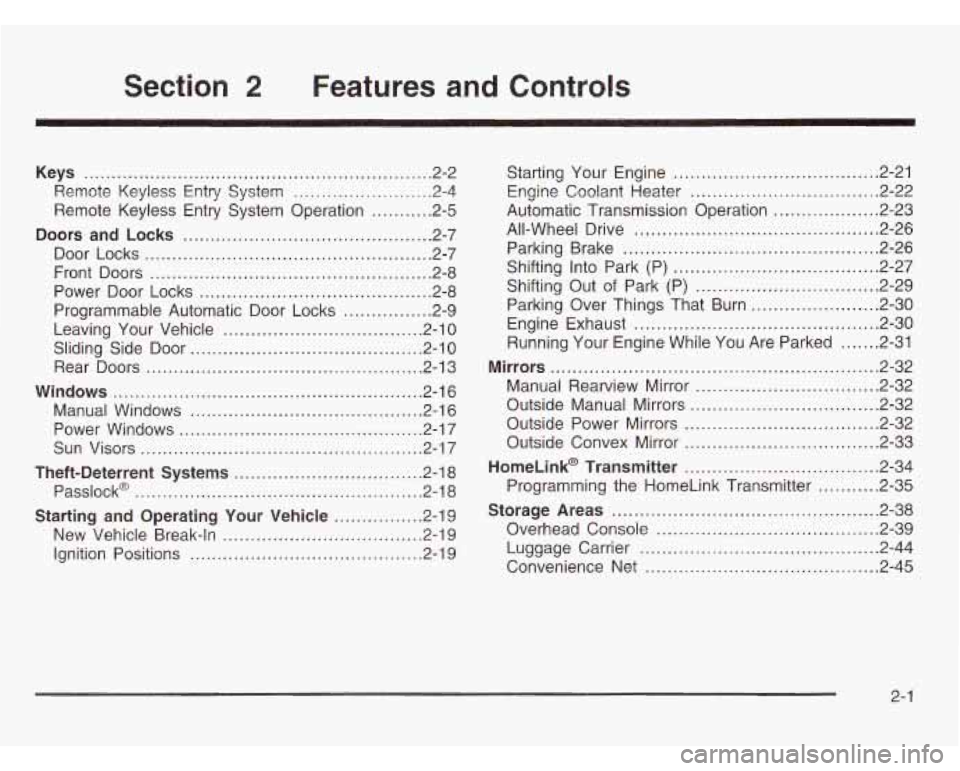
Section 2 Features and controls
Keys ............................................................... 2.2
Remote Keyless Entry System
~ = ~ . = = = = = -2-4
Remote Keyless Entry System Operation
.......... -2-5
Doors and Locks ............................................. 2-7
Door Locks
.................................................... 2.7
Front Doors
................................................... 2.8
Power Door Locks
.......................................... 2-8
Programmable Automatic Door Locks
................ 2.9
Leaving Your Vehicle
................................... -2-10
Sliding Side Door
......................................... -2-1 0
Rear Doors ................................................. -2-1 3
Windows ........................................................ 2.16
Manual Windows
.......................................... 2.16
Power Windows
........................................... -2-1 7
Sun Visors ................................................... 2.17
Theft-Deterrent Systems .................................. 2.18
Passlock@
.................................................... 2.18
Starting and Operating Your Vehicle ................ 2.19
New Vehicle Break-In
.................................... 2.19
Ignition Positions
........ ................... 2.19 Starting
Your Engine
..................................... 2.21
Engine Coolant Heater
.................................. 2.22
Automatic Transmission Operation
................... 2.23
All-Wheel Drive
............................................ 2.26
Parking Brake
.............................................. 2.26
Shifting Into Park (P)
..................................... 2-27
Shifting Out
of Park (P) ................................. 2-29
Parking Over Things That Burn
....................... 2-30
Running Your Engine While You Are Parked
....... 2-31
Engine Exhaust
............................................ 2-30
Mirrors ........................................................... 2.32
Manual Rearview Mirror
................................ -2-32
Outside Manual Mirrors
.................................. 2.32
Outside Power Mirrors
................................... 2.32
Outside Convex Mirror
................................... 2.33
HomeLink@ Transmitter ................................... 2.34
Programming the HomeLink Transmitter
........... 2.35
Storage Areas ................................................ 2.38
Overhead Console
........................................ 2.39
Luggage Carrier
........................................... 2.44
Convenience Net
.......................................... 2.45
2-1
Page 104 of 386
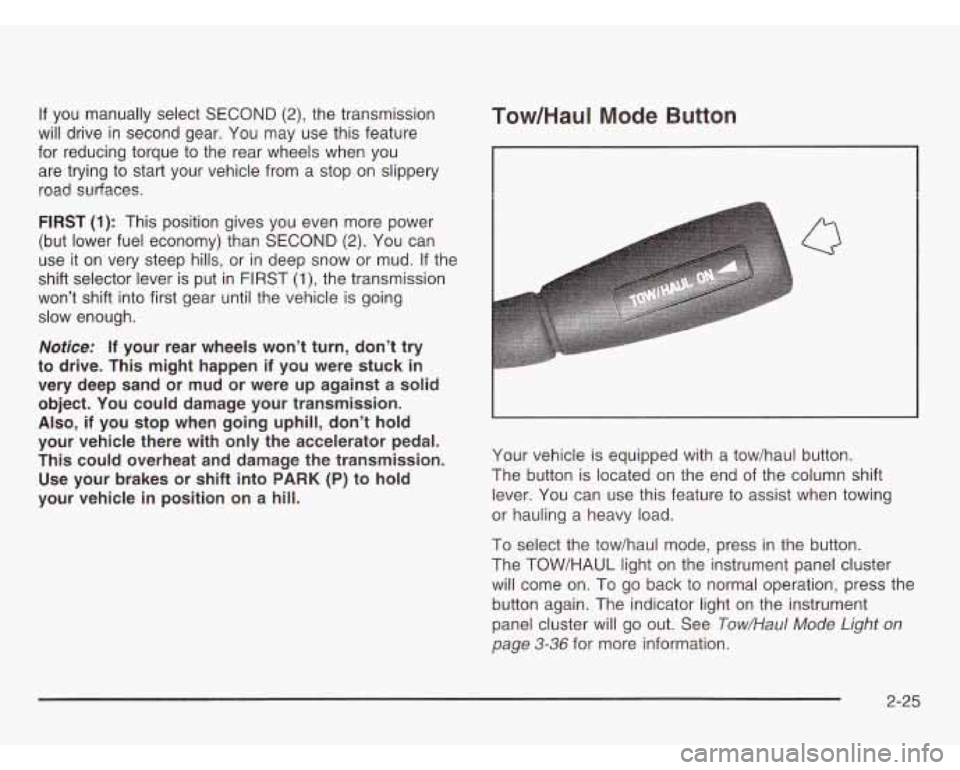
If you manually select SECOND (2), the transmission
will drive in second gear. You may use this feature
for reducing torque to the rear wheels when you
are trying to start your vehicle from a stop on slippery
road surfaces.
FIRST (1): This position gives you even more power
(but lower fuel economy) than
SECOND (2). You can
use it on very steep hills, or in deep snow or mud.
If the
shift selector lever is put in FIRST
(I), the transmission
won’t shift into first gear until the vehicle is going
slow enough.
Notice: If your rear wheels won’t turn, don’t try
to drive. This might happen if you were stuck in
very deep sand or mud or were
up against a solid
object. You could damage your transmission.
Also, if you stop when going uphill, don’t hold
your vehicle there with only the accelerator pedal.
This could overheat and damage the transmission. Use your brakes or shift into
PARK (P) to hold
your vehicle in position on a hill.
Tow/HauI Mode Button
I
Q
Your vehicle is equipped with a tow/haul button.
The button is located on the end of the column shift
lever. You can use this feature to assist when towing
or hauling a heavy load.
To select the tow/haul mode, press in the button.
The TOW/HAUL light on the instrument panel cluster
will come on. To go back to normal operation, press the
button again. The indicator light on the instrument
panel cluster will go out. See
Tow/Hau/ Mode Light on
page 3-36 for more information.
2-25
Page 139 of 386
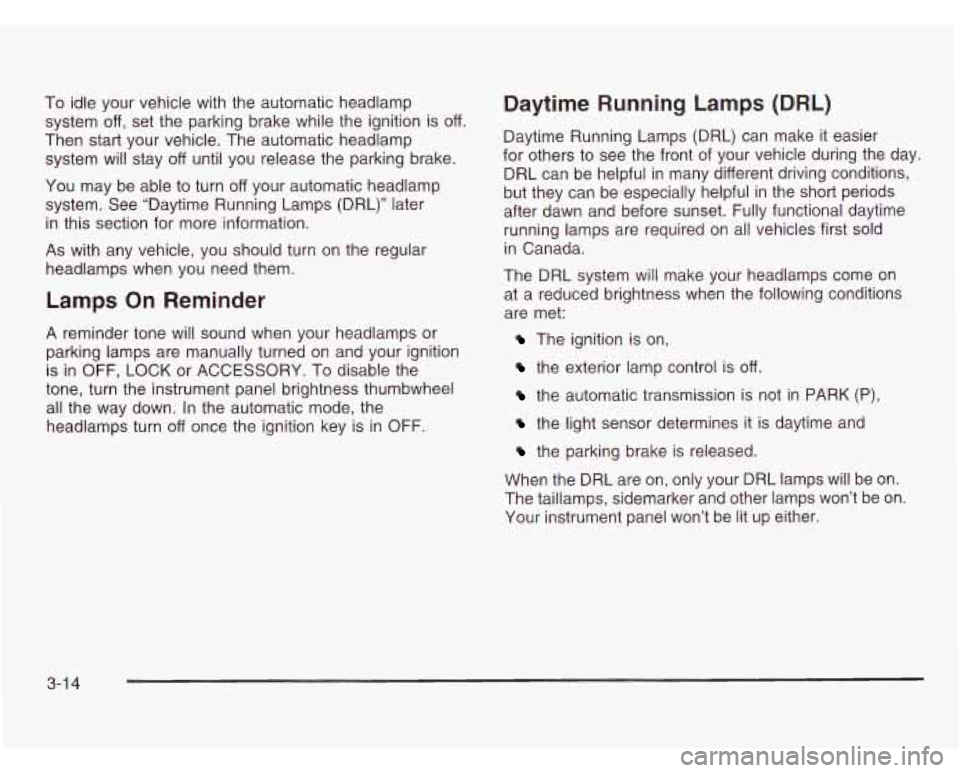
To idle your vehicle with the automatic headlamp
system
off, set the parking brake while the ignition is off.
Then start your vehicle. The automatic headlamp
system will stay
off until you release the parking brake.
You may be able to turn
off your automatic headlamp
system. See “Daytime Running Lamps (DRL)” later
in this section for more information.
As with any vehicle, you should turn on the regular
headlamps when you need them.
Lamps On Reminder
A reminder tone will sound when your headlamps or
parking lamps are manually turned on and your ignition
is
in OFF, LOCK or ACCESSORY. To disable the
tone, turn the instrument panel brightness thumbwheel
all the way down. In the automatic mode, the
headlamps turn off once the ignition key is in OFF.
Daytime Running Lamps (DRL)
Daytime Running Lamps (DRL) can make it easier
for others to see the front of your vehicle during the day.
DRL can be helpful in many different driving conditions,
but they can be especially helpful in the short periods
after dawn and before sunset. Fully functional daytime
running lamps are required on all vehicles first sold
in Canada.
The DRL system will make your headlamps come on
at a reduced brightness when the following conditions
are met:
The ignition is on,
the exterior lamp control is off.
the automatic transmission is not in PARK (P),
the light sensor determines it is daytime and
the parking brake is released.
When the DRL are on, only your DRL lamps will be on.
The taillamps, sidemarker and other lamps won’t be on.
Your instrument panel won’t be lit up either.
3-1 4
Page 215 of 386

When You Are Ready to Leave After
Parking on a Hill
1. Apply your regular brakes and hold the pedal down
while you:
start your engine,
shift into a gear, and
release the parking brake.
2. Let up on the brake pedal.
3. Drive slowly until the trailer is clear of the chocks.
4. Stop and have someone pick up and store the
chocks.
Maintenance When Trailer Towing
Your vehicle will need service more often when you’re
pulling a trailer. See the Maintenance Schedule for more
on this. Things that are especially important in trailer
operation are automatic transmission fluid (don’t overfill),
engine oil, axle lubricant, belt, cooling system and
brake system. Each
of these is covered in this manual,
and the Index will help you find them quickly.
If you’re
trailering, it’s a good idea to review these sections
before you start your trip.
Check periodically to see that all hitch nuts and bolts
are tight.
4-40
Page 265 of 386
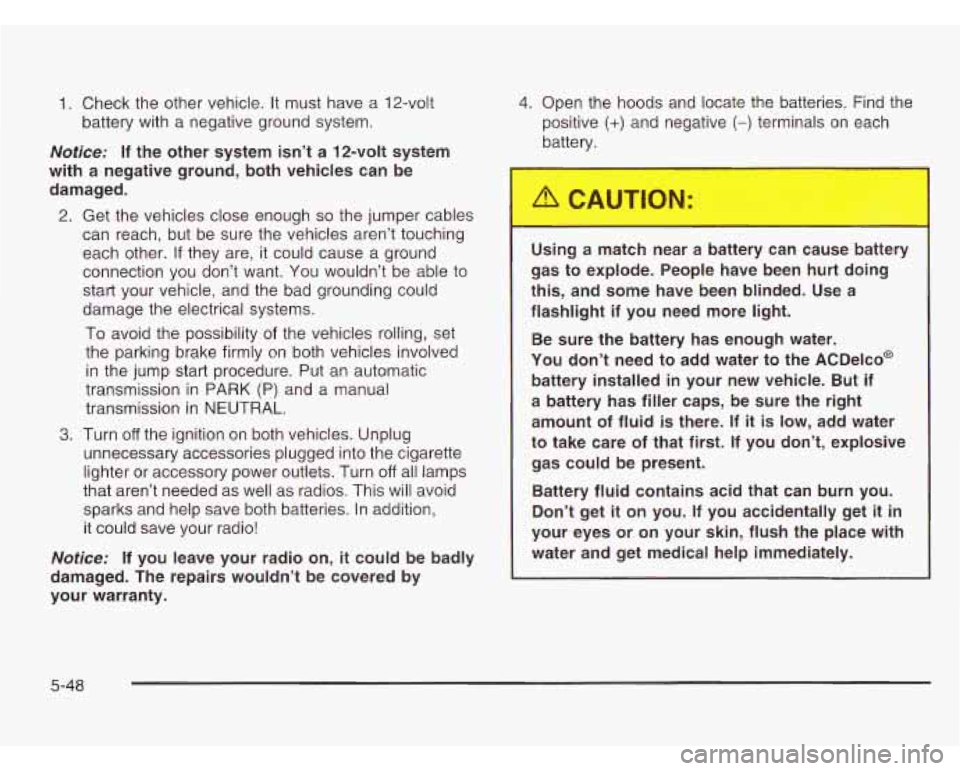
1. Check the other vehicle. It must have a 12-volt
battery with a negative ground system.
Notice: If the other system isn’t a 12-volt system
with a negative ground, both vehicles can be
damaged.
2. Get the vehicles close enough so the jumper cables
can reach, but be sure the vehicles aren’t touching
each other. If they are, it could cause a ground
connection you don’t want. You wouldn’t be able
to
start your vehicle, and the bad grounding could
damage the electrical systems.
To avoid the possibility
of the vehicles rolling, set
the parking brake firmly on both vehicles involved
in the jump start procedure. Put an automatic
transmission in PARK (P) and a manual
transmission in NEUTRAL.
3. Turn off the ignition on both vehicles. Unplug
unnecessary accessories plugged into the cigarette
lighter
or accessory power outlets. Turn off all lamps
that aren’t needed as well as radios. This will avoid
sparks and help save both batteries. In addition,
it could save your radio!
Nofice: If you leave your radio on, it could be badly
damaged. The repairs wouldn’t be covered by
your warranty.
4. Open the hoods and locate the batteries. Find the
positive
(+) and negative (-) terminals on each
battery.
Using a match near a battery can cause battery
gas to explode. People have been hurt doing
this, and some have been blinded. Use a
flashlight if you need more light.
Be sure the battery has enough water.
You don’t need to add water to the ACDelco@
battery installed in your new vehicle. But if
a battery has filler caps, be sure the right amount
of fluid is there. If it is low, add water
to take care
of that first. If you don’t, explosive
gas could be present.
Battery fluid contains acid that can burn you.
Don’t get
it on you. If you accidentally get it in
your eyes or on your skin, flush the place with
water and get medical help immediately.
5-48
Page 366 of 386
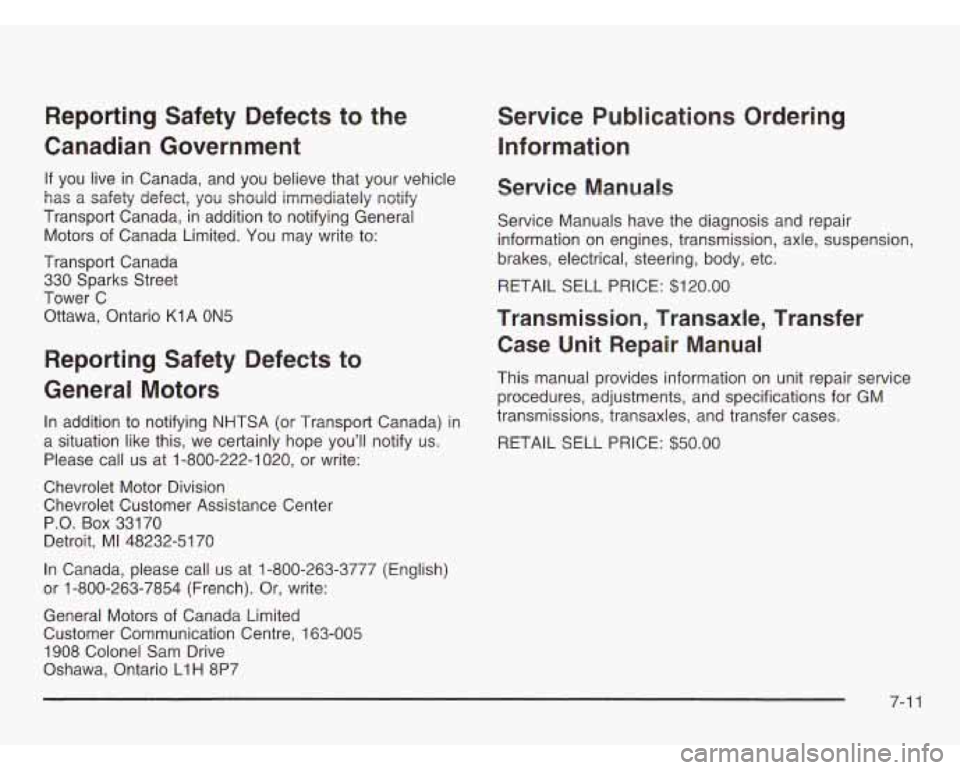
Reporting Safety Defects to the
Canadian Government
If you live in Canada, and you believe that your vehicle
has a safety defect, you should immediately notify
Transport Canada, in addition
to notifying General
Motors of Canada Limited. You may write to:
Transport Canada 330 Sparks Street
Tower C Ottawa, Ontario K1A ON5
Reporting Safety Defects to
General Motors
In addition to notifying NHTSA (or Transport Canada) in
a situation like this, we certainly hope you’ll notify us.
Please call us at 1-800-222-1020, or write:
Chevrolet Motor Division
Chevrolet Customer Assistance Center
P.O. Box 33170
Detroit, MI 48232-5170
In Canada, please call us at 1-800-263-3777 (English)
or 1-800-263-7854 (French). Or, write:
General Motors
of Canada Limited
Customer Communication Centre, 163-005
1908 Colonel Sam Drive
Oshawa, Ontario L1H 8P7
Service Publications Ordering
Information
Service Manuals
Service Manuals have the diagnosis and repair
information on engines, transmission, axle, suspension,
brakes, electrical, steering, body, etc.
RETAIL SELL PRICE: $120.00
Transmission, Transaxle, Transfer
Case Unit Repair Manual
This manual provides information on unit repair service
procedures, adjustments, and specifications for GM
transmissions, transaxles, and transfer cases.
RETAIL SELL PRICE: $50.00
7-1
1
Page 373 of 386

Gasoline Octane
........................................................ 5-5
Specifications
............................................... 5-5
Gate Operator and Canadian Programming
........ 2-36
Glass Surfaces
............................................... 5-85
GM Mobility Program for Persons with
Disabilities
.................................................... 7-5
Hatch R
H
e I' ease ......................... ........ 2-15
Hazard Warning Flashers
............................... 3-4
Head Restraints
............................................... 1-5
Headlamp High/Low-Beam Changer
.................... 3-7
Headlamp Wiring
............................................ 5-92
Headlamps
.................................................... 5-55
Bulb Replacement
.................................... 5-55
Front Turn Signal Lamps
.................. ..... 5-59
Halogen Bulbs
............................ ........ 5-55
Highway Hypnosis
........................................... 4-22
Hill and Mountain Roads
.................................. 4-22
Hitches
.......................................................... 4-36
HomeLink Transmitter, Programming
.................. 2-35
HomeLink@ Transmitter
.................................... 2-34
Hood Checking Things Under
................................ 5-1 1
Release
..................................................... 5-1 1
Horn
............................................................... 3-5 How
to Add Coolant to the Coolant
How to Add Coolant to the Radiator
.................. 5-37
How to Add Fluid
............................................ 5-27
How to Check
........................................ 5-25, 5-64
How to Check Lubricant
................................... 5-53
How to Check Power Steering Fluid
.................. 5-40
How to Use This Manual
...................................... ii
Recovery Tank ........................................ 5-34
How to Wear Safety Belts Properly
................... 1-18
Hydroplaning
.................................................. 4-18
I
If No Steam Is Coming From
Your Engine
............................................ 5-32
If Steam Is Coming From Your Engine ........... 5-31
If the Light
Is Flashing ..................................... 3-32
If the Light
Is On Steady ................................. 3-32
If You Are Stuck in Sand, Mud, Ice or Snow
....... 4-28
If You Do Decide
To Pull A Trailer ..................... 4-32
If You're Caught in a Blizzard ........................... 4-26
Ignition Transmission Lock Check
...................... 6-29
Infants and Young Children, Restraints
............... 1-38
Inflation
- Tire Pressure ................................... 5-64
Inspection Brake System
............................................. 6-31
Engine Cooling System
................................ 6-30
Ignition Positions
............................................. 2-19
6
Page 376 of 386

Matching Transmitter(s) to Your Vehicle ................. 2-5
Mexico, Central America and Caribbean
Islands/Countries (Except Puerto Rico and
U.S. Virgin Islands) ........................................ 7-5
MyGMLink.com
................................................ 7-4
New Vehicle Break-In
...................................... 2-19
Normal Maintenance Replacement Parts
........... 5-101
Odometer
............................................
Off-Road Recovery ................................
Oil
... 3-25
... 4-1 1
Engine ....................................................... 5-1 5
Pressure Gage
............................................ 3-34
Older Children, Restraints
................................ 1-35
Online Owner Center
........................................ 7-4
Operation Tips
................................................ 3-22
Other Warning Devices
...................................... 3-5
Outlet Adjustment
............................................ 3-22
Outside Convex Mirror
............................................. 2-33
Manual Mirrors
............................................ 2-32
Power Mirrors
............................................. 2-32
Overhead Console
.......................................... 2-39
Owners, Canadian
............................................... ii
Owner’s Information
........................................ 7-1 2
P
Park (P)
Shifting Into
............................. ........ 2-27
Shifting Out
of ......................... ............ 2-29
Brake
..................................................... 2-26
Parking
Over Things That Burn
................................. 2-30
Park (P) Mechanism Check
........................... 6-29
Parking Brake
and Automatic Transmission
Parking on Hills
........................................ 4-39 -39
Part A
- Scheduled Maintenance Services ............... 6-4
Part B
- Owner Checks and Services ................... 6-26
Part D
- Recommended Fluids and Lubricants ....... 6-32
Part
E - Maintenance Record ............................. 6-34
Passing
................................................. 4-12, 4-38
Passlock@
...................................................... 2-18
Payload
......................................................... 4-31
Plan Ahead When Possible
................................ 7-8
Playing the Radio
................................... 3-39, 3-41
Power
Accessory Outlets
........................................ 3-16
Door Locks
.................................................. 2-8
Electrical System
......................................... 5-92
Seat
............................................................ 1-3
Windows .................................................... 2-17
Part
C - Periodic
Maintenance Inspections ............ 6-30
Playing a Compact Disc
................................... 3-43
Steering Fluid
............................................. 5-40 9